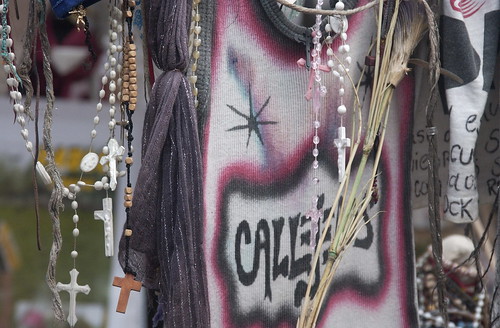At the corner of calles Mitre and Ecuador in Buenos Aires, 194 lives were lost amid the fumes and smoke that engulfed club Cromagnon on the night of December 30, 2004.
They had come on a warm night of the austral summer to hear Callejeros, one of the more popular bands on Argentina’s rock scene. When starting that evening never did they imagine that their lives would end here.
As so often with the tragic death of the young a makeshift memorial emerged. Six months later, this one remains, filled with expressions of sorrow by those who lived and those who were left behind. Gently placed on the ground or hung from a wire stretched across the now closed street are dozens of rosaries along with the remnants of everyday items once touched by those who died. What seems ordinary in life becomes cherished in death: a girl’s white tube top with the name of a favorite band delicately written on the ink in pink and black.
I first heard about this tragedy while sitting in a remote cabin high up in the northern Patagonian Andes. We had planned for several weeks without TV over the holidays. But on the drive from Neuquén we had heard about the tsunami on the radio while stopped at a gas station. As news junkies we were dismayed that we had spent several days traveling without hearing about the tsunami. After arriving at the cabin, we glad to see that it had DirecTV. As we watched the endless coverage of the tsunami, news of the nightclub fire in Buenos Aires crawled along the bottom of the screen. I called Ceci into the room from the kitchen and we turned to CNN Español, hoping for a live report from Buenos Aires.
Walking upon the club Cromagnon today, one is met with a sense of surprise and a heavy feeling as one realizes what happened here. This area of town, around Estación Once, is not so far from the well-heeled barrios where the tourists flock. But a tourist will never find his way here. Outside the train station on calle Mitre, a dozen city buses continuously drop off and pick-up passengers. Bordering calles Mitre and Ecuador is the formerly grand Plaza Miserere. At the center of the plaza is a large mausoleum containing the remains of Bernardino Rivadavia, Argentina’s first president. Standing guard around the tomb, and seemingly the only ones to care anymore about its existence, are dozens of feral cats. From their perch on the tomb the cats must have watched the horror that unfolded across the street on the night that the Cromagnon burned.
Stretched between poles and street signs outside the club are graffiti covered bedsheets, hanging like prayer flags outside a temple. The writings on these banners, that sway in the breeze, speak of a family’s sudden loss: “Voices. Voices. I hear voices in my head. Where is my daughter? Where is my sister?” [translated from the Spanish].
Above the street, shoes dangle by their laces over the electrical wire. Empty shoes, never to be worn again, have become one of the symbols of the tragedy. One of the most moving parts of the memorial is a pile of dozens of shoes that belonged to the kids who were trapped in the burning club, the emergency exits locked shut.
Stretched in front of the memorial next to the club are four rows of seats, arranged as if a meeting is about to take place. Then you realize that the seats are for families to come, sit, rest, and remember. It’s like a waiting room on the street. The rows of chairs look like they came from an actual waiting room, perhaps from the train station down the street. Some of the chairs are covered by an awning. The same awning stretches over the items left at the memorial. Between the rows of chairs has been placed a locked wooden collection box that is obviously for donations.
Scattered among the items in the memorial are a few toys, such as a stuffed “Barney”. One of the more shocking aspects of the tragedy is that among the dead included a number of very young children who had accompanied their parents to the club.
The walls outside the club are covered with haunting murals. Camping tents have been thrown up outside the doors of the club. The men staying there keep watch over the memorial. The emotional toil on the families and friends of the victims, as well as the survivors, must be tremendous. This is the kind of trauma that one never really gets over. Eventually, with time, one just learns to cope and to live with it – every day.
